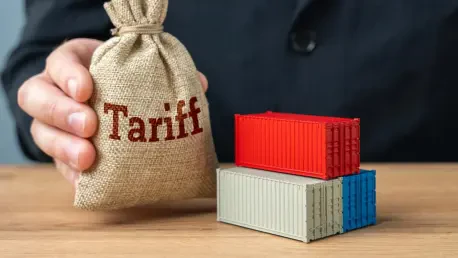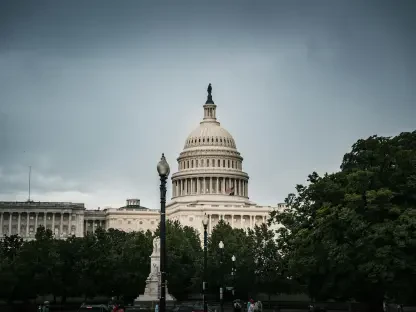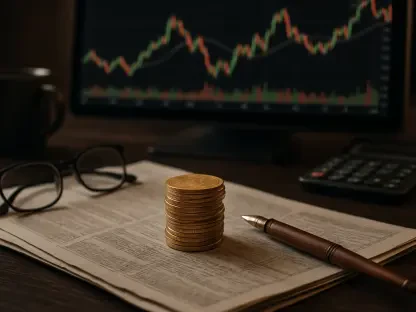On April 2, a day now dubbed “Liberation Day,” the financial landscape experienced unprecedented turbulence following the announcement of significant tariffs by former US President Donald Trump. This economic maneuver led to market chaos that unfolded with striking intensity. The S&P 500 suffered a dramatic 12% plunge, while the VIX volatility index skyrocketed from 22 to 52, signifying a colossal spike in market uncertainty and fear. Financial institutions witnessed scenes reminiscent of warfare, suggesting an epoch of economic crises. However, as financial narratives often unravel unexpectedly, this turmoil was short-lived. Within a mere two months, the S&P 500 and other significant indices rebounded, diminishing the initial panic and asserting that the disruption was a mere blip rather than a prolonged downturn.
Initial Chaos and Market Reaction
Immediate Consequences and Market Panic
The tariffs, announced suddenly, resonated deeply within global trading circles, stoking fears of an impending prolonged trade war. As the financial world grappled with this announcement, government and corporate bonds experienced significant fluctuations, reflecting investor apprehension. Both institutional and individual investors alike scrambled to navigate this uncharted territory. Panic echoed through the markets as previously secure investment landscapes transformed into arenas of unpredictability. Market strategists drew comparisons to past upheavals, with some paralleling the initial panic to the global financial crisis and the COVID pandemic’s tumultuous economic impact. However, despite such comparisons, experiential data suggested this event diverged dramatically in both scope and recovery potential.
Dynamics of the Volatility Surge
The hike in the VIX, often interpreted as the market’s fear gauge, underscored the heightened anxiety permeating through trading floors and investment portfolios. This spurt from 22 to 52 was especially shocking, marking one of the most significant increases in the index’s recent memory. Such volatility usually presages sustained periods of instability; however, the swift recovery that ensued defied many market predictions. The initial response reflected the market’s hypersensitivity to policy changes and potential disruptions in global trade networks. Although significant, the tremors seemed to stem from anticipation rather than a reflection of a long-term negative economic outcome. Analysts began to perceive the event as a testament to market resilience amidst short-lived shocks, characterized by a rapid recovery aligning more with temporary panic rather than chronic economic affliction.
Market Recovery and Stabilization
Factors Contributing to Market Rebound
A remarkable feature of “Liberation Day” was how quickly markets began to stabilize, a testament to the inherent adaptability of modern financial mechanisms. Key to this resurgence was President Trump’s subsequent delay in the complete implementation of these tariffs and the initiation of partial agreements with major trading partners. These strategic moves reassured markets, indicating that a full-blown trade war might not ensue. The reassurances provided by these diplomatic negotiations acted as a calming force amidst the initial chaos. Investors, buoyed by these partial resolutions, revised their outlooks, and stock prices began to recover, reflecting renewed confidence. This development highlighted the critical role geopolitical decisions play in affecting market trajectories.
Remaining Concerns and Long-term Considerations
Despite the rapid recovery, certain assets, especially spread products, continued to exhibit volatility. Additionally, higher long-term yields remained a concern for investors, indicating some persistent underlying instability. However, financial strategists noted that while these factors could potentially signal caution, they did not herald a full-fledged market downturn. The incident catalyzed discussions on market volatility’s inherent nature and the importance of preparedness for future economic upheavals. Comparisons with previous crises served as important lessons, emphasizing that markets could rebound quickly if underlying economic fundamentals remain strong. The narrative surrounding “Liberation Day” now serves as a reminder for investors to continually brace for unexpected events, underlining the value of strategic foresight and flexibility.
Lessons Learned and Forward-Looking Statements
Building Crisis Management Frameworks
In retrospect, “Liberation Day” stands as a pivotal case study in crisis management within financial markets. The speed at which indices recovered underscores the necessity for robust frameworks that can effectively guide market players through sudden economic shifts. Learning from this episode, institutions are likely to amplify their focus on dynamic risk assessment models to better predict and withstand future fluctuations. The need for agility and adaptability in a swiftly changing economic landscape has never been clearer. As a result, markets may increasingly invest in technologies and strategies that prioritize rapid response mechanisms, integrating data analytics to foresee and mitigate potential economic disturbances.
Preparing for Future Economic Disruptions
One striking feature of “Liberation Day” was the rapid stabilization of financial markets, showcasing the adaptability of modern economic systems. Central to this recovery was President Trump’s decision to postpone full implementation of announced tariffs and pursue partial agreements with key trading nations. These strategic diplomatic initiatives provided the markets with a sense of reassurance, indicating a total trade war might be avoided. This calming influence amid initial disorder allowed investors to reevaluate their positions, leading to a rebound in stock prices and reflecting renewed confidence in market stability. This scenario underscored the pivotal impact that political maneuvers and international relations exert on economic trends. Such decisions often steer market trajectories, highlighting how geopolitical strategies can effectively mitigate potential economic disruptions and restore investor confidence in volatile periods, illustrating the interconnectedness of diplomacy and market health.









